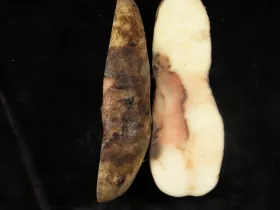Pink rot (Figure 1) is a common storage disease in potato tubers and can result in significant financial losses. This disease is caused by the soil-borne oomycete Phytophthora erythroseptica, which is favored by moist conditions, saturated soils and soil temperatures of 68 to 77 F.
Figure 1. Tuber symptoms of pink rot
Management options for pink rot include the application of soil-applied, foliar and postharvest fungicides. Under most circumstances, we do not recommend the use of metalaxyl/mefenoxam-based products due to the presence of insensitive isolates in the region, especially in west-central Minnesota.
Surveys conducted by NDSU Potato Pathology identified metalaxyl/mefenoxam-insensitive isolates in Minnesota in 2000-2008 and 2014 (Figure 2) and in North Dakota in 2003 and 2006-2010 (Figure 3). While the frequency of insensitive isolates in North Dakota remained low, in Minnesota, a trend toward decreased metalaxyl/mefenoxam sensitivity has been observed.
Figure 2. Frequency of P. erythroseptica isolates sensitive (EC50 < 1 micrograms per milliliter [µg/ml]), intermediate (EC50 1-99.9 µg/ml), and insensitive (EC50 >100 µg/ml) to metaxyl/mefenoxam in Minnesota. Adapted from Chapara et al. 2010.
Figure 3. Frequency of P. erythroseptica isolates sensitive (EC50 < 1 µg/ml), intermediate (EC50 1-99.9 µg/ml) and insensitive (EC50 >100 µg/ml) to metalaxyl/mefenoxam in North Dakota. Adapted from Chapara et al. 2010.
Metalaxyl/mefenoxam alternatives, including ethaboxam (Elumin®), oxathiapiprolin (Orondis®) and phosphorous acid (Phostrol®, Resist ٥٧®, Phiticide®, and others) have been registered. However, ethaboxam and oxathiapiprolin are labeled for in-furrow use only.
Phosphorus acid can be applied to foliage or on potato tubers going into storage. Research conducted at NDSU indicates that for Russet Burbank and other moderately resistant cultivars, the foliar application of 20 pints per acre (pt/a) early in the growing season will manage pink rot effectively.
We recommend 10 pt/a applied at a 14-day interval starting when the largest tubers are dime size. Where burning of the foliage is a concern, four weekly applications of 5 pt/a or three weekly applications at 7 pt/a should be considered. Applications up to 30 pt/a may be needed for cultivars more susceptible to pink rot than Russet Burbank.
If phosphorus acid is not available, metalaxyl/mefenoxam is registered for foliar applications for pink rot management. Two applications, the first when tubers are dime size and the second 10 to 14 days later, have been shown to be effective at managing pink rot in our field trials (Table 1). In these trials, sensitive isolates of P. erythroseptica were added to the soil of fields that likely had insensitive isolates present.
Table 1. Percentage of tuber rot at harvest and postharvest in NDSU potato pathology pink rot management trials from 2016 to 2019.
| Year |
Treatment |
Tuber rot at harvest (%) |
Tuber rot post-harvest (%) |
| 2016 |
Nontreated |
7.31 |
3.58 |
| |
Ridomil Gold® Bravo® 3.67 SC – 2 applications of 2.5 pt/a
|
3.61 |
0.93 |
| |
Phostrol® – 3 applications of 10 pt/a |
3.39 |
4.44 |
| 2017 |
Nontreated |
2.22 |
2.43 |
| |
Ridomil Gold® Bravo® 3.67 SC – 2 applications of 2.5 pt/a |
2.49 |
1.54 |
| |
Phostrol® – 3 applications of 10 pt/a |
1.69 |
1.04 |
| 2018 |
Nontreated |
4.16 |
0.04 |
| |
Ridomil Gold® Bravo® 3.67 SC – 2 applications of 2.51 pt/a |
3.60 |
0.04 |
| |
Phostrol® – 2 applications of 10 pt/a |
2.82 |
0.03 |
| 2019 |
Nontreated |
3.81 |
3.89 |
| |
Ridomil Gold® Bravo® 3.67 SC – 2 applications of 2.51 pt/a |
1.88 |
3.69 |
| |
Phostrol® – 2 applications of 10 pt/a |
1.86 |
2.04 |
Postharvest rot was evaluated at 64 days after harvest in 2016, 61 to 66 days in 2017, 69 to 74 days in 2018 and 100 days in 2019.
Trials were inoculated with P. erythroseptica isolates sensitive to metalaxyl/mefenoxam; however, insensitive isolates likely were present in the field.
However, risks are associated with the application of metalaxyl/mefenoxam-based products. Where insensitive isolates are present, efficacy of metalaxyl/mefenoxam products could be decreased (Figure 4).
Figure 4. Percentage of rot at harvest when Russet Burbank was treated with Ridomil® in-furrow or Phostrol® at tuber-set and ١٤ days later and inoculated with 25% to 75% of a metalaxyl/mefenoxam-insensitive P. erythroseptica isolate. Results are from a 2009 field trial (Chapara et al. unpublished).
NDSU research results indicate that when increasing proportions of insensitive P. erythroseptica isolates were added to the soil, pink rot control provided by Ridomil decreased. Also, the application of these products has the potential to increase the proportion of insensitive isolates in a field. We highly encourage the use of non-metalaxyl/mefenoxam products whenever possible but when a shortage of phosphorus acid products occurs, that may not be feasible.
While it provides no protection against in-season infections, a postharvest application of phosphorus acid has been demonstrated to be effective at preventing pink rot in storage and may be something to consider if you cannot obtain the product earlier in the season. Effective management includes good coverage of tubers with phosphorus acid without overwetting the tubers. We recommend the application of 12.8 fluid ounces per ton (fl oz/ton) of tubers with 0.5 gallon of water/ton of tubers.
As always, fungicides should be used as part of an integrated pest management scheme that includes planting moderately resistant cultivars, minimizing end-of-season irrigation, allowing adequate skin set before harvest, ceasing harvest when pulp temperatures exceed 65 F, limiting wounding at harvest and removing rotted tubers going into storage. Limiting harvest wounds is especially important when metalaxyl/mefenoxam is used because studies suggest that wounding could limit its efficacy.




